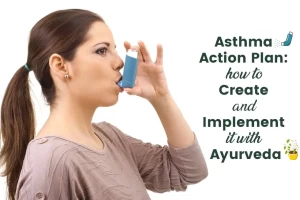Are hay fever and rhinitis the same? How to treat it na...
Many peop...
Read more...In Ayurveda, Stasis dermatitis is known as "Vataja Twak Vikara" or "Vataja Charmaroga." According to Ayurveda, Stasis dermatitis is primarily caused by an imbalance of Vata Dosha, Kapha Dosha, and Pitta Dosha. These Doshas control the movement and circulation in the body. When these are imbalanced, it can lead to dryness, poor circulation, and accumulation of toxins (Ama). It is characterized by dry, itchy, inflamed, and discolored skin. It is generally associated with poor blood circulation in the lower extremities, especially the legs. The stagnant blood and impaired circulation can result from factors such as a sedentary lifestyle, prolonged standing or sitting, obesity, and certain diseases like varicose veins. Stasis Dermatitis Ayurvedic Treatment is effective and chemical-free. It includes lifestyle changes, dietary recommendations, and exercise routines (Yoga asanas, Pranayama, Walking), aimed at improving circulation and promoting long-term healing.
Stasis dermatitis, also known as Venous Stasis dermatitis. It is primarily associated with impaired blood flow and circulation in the lower extremities. Several causes of stasis dermatitis and risk factors can contribute to its development, including:
Yes, Ayurveda manages stasis dermatitis very well with the help of the following Ayurvedic practices:
Ayurveda gives importance to a balanced and nutritious diet. Specific dietary changes are made to reduce inflammation and support healthy skin according to the “Prakriti” of the patient. Lifestyle transformations such as stress reduction techniques, regular exercise, and maintaining proper hygiene can also be beneficial.
Ayurveda utilizes a fabulous treasure of herbs for the cure and management of stasis dermatitis. Herbs reduce inflammation and soothe the skin. Some commonly used herbs for dermatitis include Neem, Turmeric, Aloe vera, and licorice.
Ayurveda recognizes the mind-body connection and practices like yoga and meditation to promote the overall health of an individual. These practices can help reduce stress, improve circulation, and support healthy skin.
In conclusion, with the holistic and individualized approach of Ayurveda, a skin condition like Stasis dermatitis can be managed effectively. Ayurvedic treatment methodology focuses on detoxification, encouraging healthy circulation, and balancing the Doshas. Moreover, with the glory of herbs, lifestyle changes, and yoga asana, the symptoms of stasis dermatitis can be relieved. Thus, healing can take place in the affected area of the skin. Adopt Ayurveda as a means to stay healthy, fit, and vibrant.
Ayurveda treats the individual as a whole and not only the disease. The root cause of the disease is treated without any side effects in the most natural Ayurvedic way. Hence, it is the most promising treatment for managing various skin conditions, including Stasis dermatitis. Ayurvedic treatments for stasis dermatitis aim to address the imbalance of the dosha in the body and focuses on personalized treatment plans according to the individual's unique Prakriti and Vikriti.
According to Ayurveda, the root cause of Stasis dermatitis lies in the imbalance of the dosha, tridosha Vata Dosha, Kapha Dosha, and Pitta Dosha. When there is an excess or aggravation of these doshas, it disrupts the normal functioning of the circulatory system, leading to poor blood circulation and lymphatic flow in the legs. This stagnant blood and lymph then cause swelling, inflammation, and tissue damage, resulting in stasis dermatitis. Ayurveda also considers impaired digestion and metabolism (Agni) as a contributing factor to the development of stasis dermatitis. When Agni is weakened, it leads to the accumulation of toxins (Ama) in the body, which can be seen in Stasis dermatitis.
While turmeric (Curcuma longa) has so many beneficial properties for the skin, including its anti-inflammatory, antioxidant, and anti-microbial effects, it is important to consult with an Ayurvedic physician for the proper line of treatment according to the Prakriti (constitution) of the patient.
Ayurveda has several excellent herbs that are known for their beneficial properties in managing stasis dermatitis such as Neem (Azadirachta indica), Turmeric (Curcuma longa), Manjistha (Rubia cordifolia), Aloe Vera (Aloe barbadensis), Guduchi (Tinospora cordifolia) and Licorice (Glycyrrhiza glabra).
With proper Ayurvedic treatment and management through lifestyle changes, it is possible to significantly improve the symptoms and reduce the frequency and intensity of stasis dermatitis episodes.
Stasis dermatitis is a chronic and progressive condition that can be life-threatening. If left untreated or poorly managed, the condition can progress, leading to more severe symptoms and complications. Complications can include skin ulcers, open sores, skin infections, and cellulitis. These complications can cause pain, discomfort, and difficulty in healing, and can potentially lead to further severity of symptoms if not properly managed.
Stasis dermatitis itself is not contagious and cannot spread from person to person. It is a localized skin condition where venous insufficiency in the lower legs or ankles takes place. If it worsens or if it is left untreated, it can lead to the development of venous ulcers.
Blog Posts about the disease and their Ayurvedic treatments


Nowadays, Asthma is the most common disease tha...
Read more...
Asthma primarily affects the respiratory system...
Read more...